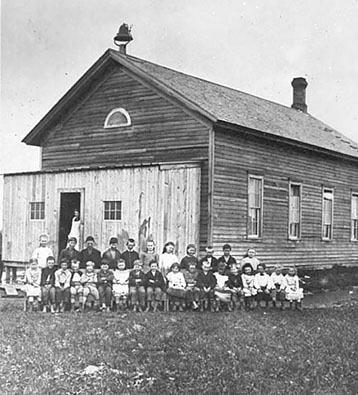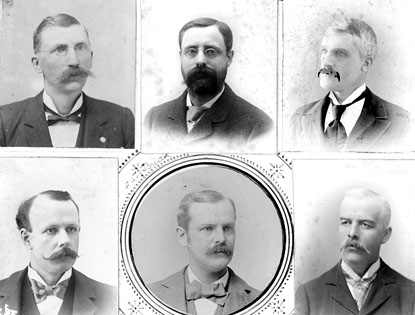Earliest Public Schools
The first school session in Fargo was held in the summer of 1872 (reportedly in a log cabin in the vicinity of what is now Island Park). Mercy Nelson (age 15) was the teacher. Ms Nelson was to become Mrs. Eben W. Knight of Lisbon, ND.
The next school appears to have been held in a hall at the corner of Fourth and Front Streets with Miss Alvira F. Pinkham as teacher of 15 students. I believe the hall was owned by the teacher's brother, Francis (Frank) Pinkham. School at that time was financed by funds raised through subscription.
In one of the earliest records, A. McHench, Cass County School Superintendent reported in November 1874 to the Dakota Territory Superintendent of Public Instruction that Cass County had organized one school district [Fargo] six months previously and had a school house that that would accommodate 76 scholars. McHench reported that Cass County had 27 males and 36 females between the ages of 5 and 21 years, of which 17 males and 24 females attended school. McHench also reported that the school term was three months long and was taught by Miss A.M. Giddings, who was paid $45 per month.
On September 24, 1874, the voters authorized the purchase of a schoolhouse and in June, 1875, two notes worth $532 were drawn to A. McHench for the purchase of Fargo's first official public school house. It was located on the northwest corner of Second Avenue and Ninth Street South. The lot was given to Fargo by the Northern Pacific railroad for school purposes.
The school is pictured to below in an 1878 photograph from the F. J. Haynes Collection (2029.8.31) of the North Dakota State University, North Dakota Institute for Regional Studies.
Classes were held in this school with a three-month winter course and a three-month summer course. A growing enrollment caused another one-room building to be added and later still two more rooms were added. The resulting four-room building was designated the "high school." This building remained until the the first part of the Central High School was erected in 1882. At that time, the old school was abandoned for school purposes. In August 1884, one of the rooms was moved to the site that was to become the Hawthorne school. When Hawthorne was completed, the old school building was moved yet again to a site on Third Avenue South and was remodeled and used as a dwelling.
The two-room addition to the original school was moved to the site of the original Longfellow school and was known as the Douglas Terrace school. Later the two rooms were separated and moved to new sites where they were also remodeled as residences.

When the lot of the early school was sold to the Unitarian Church, the original and historic school was moved in January 1885 to a site on NP Avenue east of Third Street and continued to be used as a school. It was later vacated but in 1893 regained use in 1893 by students at Lincoln when that school was destroyed by fire in 1893. When the Kindergarten Society started work in Fargo, they asked if they could use the old school building. The school board donated the building and it was moved to a site on the NP railroad right-of-way (north side of Front Street, about a block west of the bridge) where it served for many years as a free kindergarten and nursery school. Later the building was again moved to a location north of the Washington School for a similar purpose. When the kindergarten was discontinued, the school was deeded to the city of Fargo for use as a day nursery (the Fargo Nursery) and it was moved to a site east of Washington School between Third and Fourth Streets on First Avenue South. The building still stood in the late 1950's. I do not know if this historic building has been preserved but it was certainly well-traveled and well worth the effort to keep. Perhaps it is a parking lot today, the fate of many of Fargo's historic buildings.
On September 24, 1874, the voters authorized the purchase of a schoolhouse and in June, 1875, two notes worth $532 were drawn to A. McHench for the purchase of Fargo's first official public school house. It was located on the northwest corner of Second Avenue and Ninth Street South. The lot was given to Fargo by the Northern Pacific railroad for school purposes.
The school is pictured to the right in this 1878 photograph from the F. J. Haynes Collection (2029.8.31) of the North Dakota State University, North Dakota Institute for Regional Studies.
Classes were held in this school with a three-month winter course and a three-month summer course. A growing enrollment caused another one-room building to be added and later still two more rooms were added. The resulting four-room building was designated the "high school." This building remained until the the first part of the Central High School was erected in 1882. At that time, the old school was abandoned for school purposes. In August 1884, one of the rooms was moved to the site that was to become the Hawthorne school. When Hawthorne was completed, the old school building was moved yet again to a site on Third Avenue South and was remodeled and used as a dwelling.

Pictured right are the members of the 1885 Fargo School Board. Clockwise from the upper left are F.W. Peterson, E.H. Lambert, A.C. Henderson, John Forsyth, F.H. Bristol, and Thos. Baker, Jr.
The photograph is from the Historical Society of North Dakota Museum Collection D0179.
There were five public schools in Fargo by 1896. Each was known by the number of the ward in which it was located. It was decided by the School Board that that names of the schools were to be left to the pupils (with final selection left to the discretion of the teachers). The November 11, 1896 School Board minutes recorded the results: Washington, High School, Lincoln, Longfellow, and Hawthorne.
By 1909, there were eight schools; the three newest schools were Roosevelt, McKinley, and the Douglas Terrace School.
